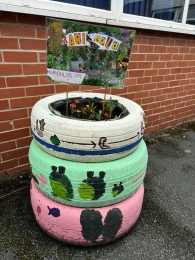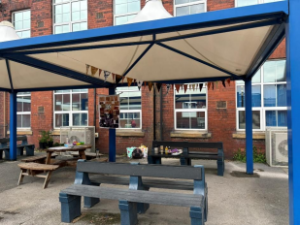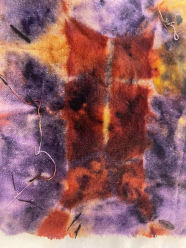Background
In 2023, SPARK, Wakefield’s Local Education Partnership received funding from Bridge organisation IVE, and Wakefield Council to undertake a teacher CPD programme entitled ‘Culture on Your Doorstep.’ The programme aimed to upskill teachers and increase their confidence in creative and cultural learning. The focus was on exploring ways to build their students’ cultural capital using local arts, culture and heritage.
Wakefield Museums and Castles is a key partner organisation within SPARK, having been involved in the LCEP since its inception in 2016.
Castleford Academy has good links with many cultural organisations across Wakefield and the school were excited to be involved in SPARK’s Culture on Your Doorstep pilot programme. They wanted to give departments outside of performing and visual arts an opportunity to work with artists and cultural organisations to explore ways to enhance local cultural links and creativity within their curriculum.
The Challenge
The science department felt that students would benefit from more local context when learning about Ecology. Their curriculum time is taken up with teaching the statutory knowledge and skills, meaning lesson time for new content is limited. However, staff were keen to explore ways to add local knowledge within lessons where possible and to build upon this work with a smaller group of students at the after school Environmental Club.
The Approach
SPARK partner Wakefield Museums and Castles was paired with Castleford Academy for the project. Department leaders met with education and curatorial staff from the museum to discuss local themes that could be incorporated into lessons using museum resources and knowledge. Teachers were intrigued to learn about local Victorian environmentalist Charles Waterton’s pioneering work to conserve the species on his land in the village of Walton in Wakefield, and his campaigns against pollution and poaching. Trust partner school, Crofton Academy, located close to Walton, were also brought on board to be involved in the teacher CPD and lesson planning.
“We felt it was important for pupils to know that a famous, pioneering scientist lived and worked in the local area.” (Head of Science)

Year 8 Ecology Lessons
Museum staff shared their knowledge and brought objects from the collection to Castleford inspire teachers with ideas for how Waterton’s story and actions could be incorporated into their lessons. His story has a darker side too – Waterton worked for 7 years on his family’s plantation in British Guinea where enslaved people were exploited – and the schools wanted to find ways for students to understand these different aspects of Waterton’s life and consider his legacy today.
“Our hope was that pupils would engage more with the topic of Ecology and also gain an appreciation of who Charles Waterton was and why his work was important.” (Head of Science)
Extra-Curricular KS3 Environmental Club
Castleford Academy’s after school KS3 Environmental Club was the ideal platform for students to explore the topic of local ecology and sustainability further in a more creative way. SPARK funded a local artist, Jane Howroyd, to work with lead teacher Lucy Norton to co-plan and deliver a creative, student-led project for the weekly club. Jane guided the students to make and decorate planters made from old tyres and use them to grow plants and create natural dyes, simultaneously upskilling Lucy in dying techniques and working with the students in the co-planned sessions.
“I hope the students will develop a deeper understanding of sustainability and its effects on the local environment/area.” (Jane Hoyroyd, Artist)
“This partnership will help me to develop my collaboration and communication skills as well as establish a legacy project for my school that can be repeated each year.” (Lucy, Teacher)

Obstacles and Issues
It soon became clear that the original time frame of one term for the Environmental Club project would be insufficient. SPARK was able to help, by funding Jane to work with the school across the whole of the 2023-24 academic year. Her in-school sessions were spread throughout the year to enable her to be involved in the whole cycle of the project – designing planters, growing and dying. Both Jane and Lucy were pleased with this outcome.
“My aim is to develop a longer-term project around natural dyes which offers legacy through allowing for future more advanced project work after the year of the project finishes.” (Jane, Artist)
Outcomes and Outputs
Armed with knowledge and resources about Charles Waterton, and supported by the Wakefield Museums and Castles’ curator, Castleford and Crofton teachers planned their new lessons. The schools also received loans boxes from the museum, funded by SPARK, giving students the opportunity to discover and handle objects related to the topic in class. The schools were pleased with how the lessons were received by the students and hope to expand the topic further in future years.
“Y8 pupils engaged with the learning and it was made relevant to them with him being so local.. Next time I would look to add in another 1 or 2 more lessons. This is to allow the students time to do some more research on Charles Waterton and explore the things he did.” (Crofton Academy teacher)
The Environmental Club project was also a very successful collaboration. Lucy and Jane worked together to plan and deliver weekly sessions across the year and took time each half term to reflect upon the partnership and what they had learnt from it. Both parties felt that they had gained valuable knowledge and experience from working together in this way.
“Working together allowed us to develop and adapt the project. I think the biggest achievement for me was my understanding of how a project can work with collaborative planning.” (Jane, Artist)
Comments from pupils during the sessions showed how proud they also were of what they had achieved:
“I’ve never done this before.” “How do I do this at home?” “Can I take my journal home to show my family what we’ve done?”
“Pupils engaged exceptionally well and took ownership of their work.” (Lucy)


Project legacy and future learning
In terms of the curriculum element of the project, the lack of lesson time to fully develop students’ knowledge and understanding of both Charles Waterton and the local context, was a challenge for teachers. Teachers also expressed hesitation in using the objects from the loans boxes with students, for fear of them being damaged. In future, teachers would benefit from further training in using these objects to increase their confidence.
Lucy and Jane learnt a lot from each other during the extracurricular element of the project, and Lucy now feels confident to repeat the project in future. Working with an artist has also given her many new ideas for other projects she could work on with her pupils in future.


